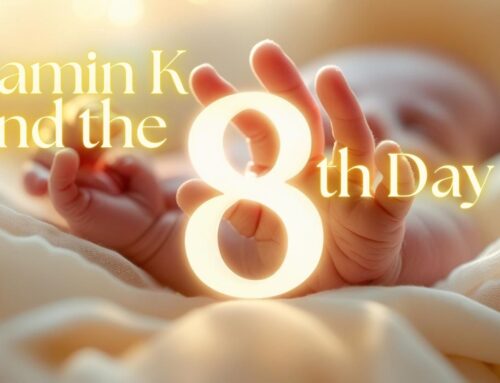The Role of Sandek Explained
Who? What? Where? When? Why?
Let’s explore the most commonly asked questions surrounding the role of a Sandek, addressing the “who, what, where, when and why”.
1. What is a Sandek?
The Sandek is a person bestowed with the highest honor during a Jewish Bris Milah ceremony.
This individual plays a central role in the ritual, traditionally cradling the baby boy on his lap while the Mohel performs the circumcision.
The sandek assists the Mohel by holding the child’s legs during the circumcision procedure.
2. What is the source for the role of Sandek?
The role of Sandek has sources nearly as old as the circumcision itself.
In the first book of the Torah, towards the end of Parshas Vayechi (Genesis 50:23) Yosef’s great grandchildren are said to have been born upon his knees. The commentary (Yonoson Ben Uriel) explains that Yosef (Joseph) was honored with the role of Sandek for his great grandchildren.
King David wrote in Tehillim (Psalms 35:10) “All my bones say ‘Hashem who is like you?’”. The midrashic commentary upon this verse explains that every bone in one’s body should be used in the service of God. How are the thigh bones and knees used? By holding up the baby during the Bris.
The role of Sandek was codified into Jewish law by the Rema, Rabbi Moshe Isserles, within the laws of Bris Milah (Shulchan Aruch, Yoreh De’ah 265:11).
3. Who should be Sandek?
The selection of the Sandek is a decision of great importance.
The Sandek must be a Jewish male, preferably a righteous individual of pious character and spiritual observance.
Mystical sources teach that the noble character traits of the Sandek are transmitted to the baby during the Bris Milah.
- This is why many choose to honor a revered Rabbi or Torah scholar with this role.
- Others have the custom to honor the grandfathers, especially when they are observant and G-d-fearing, for the first two grandsons. According to this custom, typically the paternal grandfather is honored first, then the maternal grandfather.
- Still others choose to honor their personal spiritual role model with the role of Sandek.
Regardless of who is chosen for Sandek, it is advised that they maintain thoughts of Torah or thoughts of blessing during the Bris Milah.
4. Where does the Sandek sit?
Jewish tradition teaches that the spirit of Elijah the Prophet visits every Bris Milah.
In such, many congregations have a richly decorated chair designated as the כסא של אליהו (Chair of Elijah).
During the Bris Milah ceremony, the Sandek is seated either in the Chair of Elijah or directly next to it.
In a situation where the congregation does not have a designated Chair of Elijah, any chair (or two stacked chairs) may be designated as the Chair of Elijah as part of the Bris Milah ceremony.
5. Where does the term Sandek come from?
There are various opinions as to the Etymology of the word Sandek, also spelled sandak (Hebrew: סנדק).
Some suggest that “sandek” originates from a Greek word meaning “representative,” implying that the sandek acts as an agent of the father. This aligns with the German-Jewish tradition, where the equivalent figure is known as the gefater or godfather.
This also explains why in Modern Hebrew, the term “sandak” doubles as the term for godfather. For example, the famous film “The Godfather” was translated in Hebrew to “HaSandak”.
Another theory as to the origin of the term “sandek” has been proposed to stem from the Greek “sunteknos”, composed of “syn-“ (meaning “plus”) and “tekno” (meaning “child”), signifying “companion of the child”.
This makes sense as the Sandek holds the baby during the ceremony. Some maintain that a sandek is like a partner in the mitzvah of milah since he holds the baby on his knees and helps the mohel.
6. When is one Sandek? (As opposed to Godfather)
While the roles of “Sandek” and “Godfather” may overlap linguistically, and both figures hold positions of honor and responsibility, their similarities in practice are quite limited.
The godfather, as portrayed in Western contexts such as in “The Godfather” film, typically assumes a lifelong role of protector and mentor, unrelated to religious rites. The godfather’s role often revolves around familial bonds and worldly guidance.
The role of the Sandek on the other hand is exclusive to the time of the Bris Milah. The impact of the Sandek, as mentioned above, is primarily via a form of spiritual osmosis to imbue the child with the refined character traits which he toiled in life to develop himself.
It is important to note that as an expression of gratitude for the bestowed honor, it is customary for the Sandek to give a gift to the child or the child’s mother.
Similarly, the Sandek will often sponsor the festive meal in celebration of the Bris.
7. Why is being Sandek the highest honor at a Bris?
The designation of the Sandek as the highest honor at a Bris Milah is rooted in deep traditions and symbolism.
The cherished role of Sandek is compared to a Cohen (Priest) offering the incense offering in the Beis Hamikdash (Holy Temple in Jerusalem). Just as the one who performed the incense offering was blessed with wealth, so too the Sandek is blessed with wealth.
Some explain that wealth does not mean monetary wealth, but rich with success. The Satmar Rebbe said that wealth in this context means wealthy in mind, long life, and good children.
It is for this reason, that aside for the High Priest, a Cohen was never honored with the incense offering more than once, so as to share the wealth. So too, as a general rule, one person should not be appointed as Sandek for more than one child in the same family.
8. What should one do to prepare for the role of Sandek?
- The sandek should get a haircut before the milah.
- There is a prevalent custom for the Sandek to go to the mikvah to purify himself before the Bris Milah.
- He should get dressed in his finest Shabbos clothes.
- Some maintain that the sandek should not eat before the Bris. This is to show honor to the mitzvah that he will be performing.
- The sandek should don himself with a tallis and tefillin to wear when the Bris is taking place.
- If there is Torah reading on the day of the Bris Milah, the Sandek will usually be honored with an “Aliyah”, being called up to make a blessing before the Torah reading.
Have more questions about the role of Sandek or other aspects of Bris Milah?
Ask us all the hard questions about circumcision including Standards of care, Guidance and Support before and after a Bris Milah, Metzitza B’peh, Pidyon Haben for Firstborn Sons, etc.
We’re here for you. Click the link below to find the best ways to reach us.



